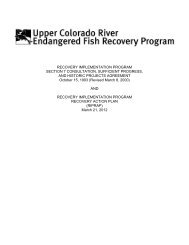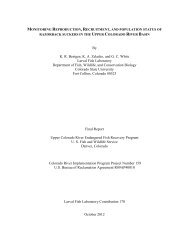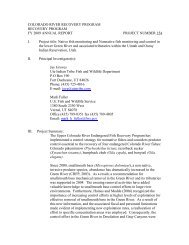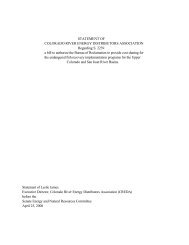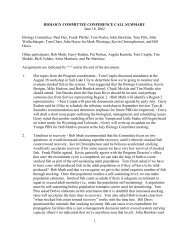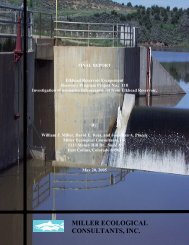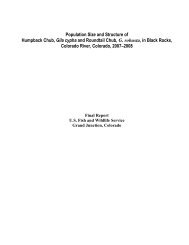population response. However, until these recovery goals are established, trends in certainpopulation indices (Appendix D) will provide an interim assessment <strong>of</strong> a species’ progress towardrecovery.6. Long-Term FundingThe Recovery Program participants will pursue and support introduction <strong>of</strong> long-term fundinglegislation in the Senate and House <strong>of</strong> Representatives during the 106th Congress. The legislationis to authorize cost shared funding <strong>for</strong> both the San Juan River and Colorado River RecoveryPrograms. The purpose <strong>of</strong> the legislation is to authorize and provide funding <strong>for</strong> theimplementation <strong>of</strong> all the Recovery Activities <strong>of</strong> the Recovery Program within the currentlyestablished time schedule. This legislation is essential to the implementation <strong>of</strong> the RecoveryActions described above. The legislation will include authorization <strong>for</strong> both capital and basefunding.The Recovery Program participants also will continue to pursue and support annual Federal andState appropriations and revenues, as needed, that fund full implementation <strong>of</strong> the RecoveryActions identified within this opinion. This includes both capital funding and annual base funding.Capital funding is <strong>for</strong> planning, design, permitting or other compliance, construction, constructionmanagement, replacement <strong>of</strong> facilities, and the acquisition <strong>of</strong> interests in land or water, asnecessary to carry out the Recovery Program. These capital items include hatchery additions <strong>for</strong>the genetic conservation and propagation <strong>of</strong> the endangered fishes, the restoration <strong>of</strong> floodplainhabitat, fish passage, acquisition <strong>of</strong> water <strong>for</strong> instream flows (water leases), and the removal ortranslocation <strong>of</strong> nonnative fishes. Capital funding <strong>of</strong> up to $62,000,000 <strong>for</strong> the Recovery Programis to continue through the year 2005. These activities are substantially cost shared with non-Federal contributions by Upper Basin States and power users.Base funding is <strong>for</strong> the operation and maintenance <strong>of</strong> capital projects, implementation <strong>of</strong> RecoveryActions other than capital projects, monitoring and research to evaluate the need <strong>for</strong> oreffectiveness <strong>of</strong> any recovery action, and program management, as necessary to carry out theRecovery Program. Base funding also includes annual funding provided by the Service,Reclamation, Colorado, Utah, and Wyoming under the terms <strong>of</strong> the 1988 CooperativeAgreement. Base funding <strong>for</strong> the Recovery Program from power revenues will be up to$4,000,000 per year, adjusted <strong>for</strong> inflation.Existing and New DepletionsExisting depletions anticipated to continue into the future, addressed in this biological opinion,consist <strong>of</strong> Reclamation and non-Federal depletions as described in the Federal action on page 1.Existing project depletions are defined below. Only the amount <strong>of</strong> water that was depleted as <strong>of</strong>September 30, 1995, is considered an existing use or depletion <strong>of</strong> water, except as defined <strong>for</strong>Green Mountain and Ruedi Reservoirs below. Project depletions above this level are considered17
“new” depletions. This would include depletions from new, as yet unbuilt projects, and additionaldepletion occurring after September 30, 1995, from existing projects. Existing depletions shallremain characterized as “existing depletions” regardless <strong>of</strong> any subsequent change, exchange, orabandonment <strong>of</strong> the water rights resulting in such depletions. Also, existing depletions transferredto other facilities remain existing depletions so long as there is no increase in the amount <strong>of</strong> totaldepletions attributable to existing depletions.Existing depletions are defined as follows 2 :a) existing depletions anticipated to continue into the future from the Upper ColoradoRiver Basin above the confluence with the Gunnison River are those that actually occurredon or be<strong>for</strong>e September 30, 1995 (approximately 1 million acre-feet/year);b) depletions associated with the total 154,645 acre-feet volume <strong>of</strong> Green MountainReservoir, including the power pool (which includes but is not limited to all <strong>of</strong> the 20,000acre-feet contract pool and Historic User’s Pool), and the Colorado Big-ThompsonProject replacement pool; andc) depletions associated with Ruedi Reservoir including but not limited to, Round I sales<strong>of</strong> 7,850 acre-feet, Round II sales <strong>of</strong> 17,000 acre-feet as discussed in the Service’sbiological opinion to Reclamation dated May 26, 1995, and as amended on January 6,1999, and the Fryingpan Arkansas Project replacement pool as governed by the operatingprinciples <strong>for</strong> Ruedi Reservoir, but excluding 21,650 acre-feet from the marketable yield.New depletions are defined as average annual depletions from new or existing projects occurringafter September 30, 1995, and excludes existing depletions as defined above. New depletions willbe calculated as a 10 year moving average as determined by the CWCB and reported to theService and Recovery Program by January 1 <strong>of</strong> every odd numbered year (beginning January 1,2001) as described in Appendix B.Water users that choose to use the implementation <strong>of</strong> Recovery Actions under the RecoveryProgram <strong>for</strong> Endangered Species Act compliance will be required to sign a Recovery Agreement(Appendix E), except Reclamation will not be required to sign these agreements as discussed laterin this opinion. In the Recovery Agreements, individual water users will agree not to take anyaction which would probably prevent the implementation <strong>of</strong> the recovery actions <strong>of</strong> the RecoveryProgram and to take reasonable actions required to implement the recovery actions. The Serviceanticipates that water user entities controlling a majority <strong>of</strong> existing depletions above theGunnison River will sign Recovery Agreements within 120 days <strong>of</strong> issuance <strong>of</strong> this biologicalopinion, pending review <strong>of</strong> the opinion and approval <strong>of</strong> the recovery agreement by their governing182 This definition is <strong>for</strong> the purpose <strong>of</strong> defining depletions, a part <strong>of</strong> the Federal action subject toconsultation, and includes as “existing depletions” some water from Reclamation facilities that isnot currently being depleted or water that has not actually been depleted.
- Page 1 and 2: FINAL PROGRAMMATIC BIOLOGICAL OPINI
- Page 3 and 4: INCIDENTAL TAKE ...................
- Page 5 and 6: 2" Reclamation’s portion of 120,0
- Page 7 and 8: On January 21-22, 1988, the Secreta
- Page 9 and 10: funding component of the Recovery P
- Page 11 and 12: 81. Habitat Protection ElementGener
- Page 13 and 14: Also, the Service and the Colorado
- Page 15 and 16: Table 1. The estimated benefits in
- Page 17 and 18: through recovery efforts that will
- Page 19: native fishes. Also, some species o
- Page 23 and 24: Based on early fish collection reco
- Page 25 and 26: infrequent pulsed recruitment make
- Page 27 and 28: Area, in the Loma to Black Rocks re
- Page 29 and 30: 26Figure 1. Distribution of adult C
- Page 31 and 32: during high flows. Some of the pike
- Page 33 and 34: In the Upper Basin, above Glen Cany
- Page 35 and 36: 32Populations DynamicsThere are no
- Page 37 and 38: in low velocity shorelines and back
- Page 39 and 40: 36IMPORTANCE OF THE 15-MILE REACHTh
- Page 41 and 42: occur in the 15-Mile Reach). Provid
- Page 43 and 44: Applying the above regulations, the
- Page 45 and 46: in a river basin. While the model i
- Page 47 and 48: 44Factors Affecting Species Environ
- Page 49 and 50: 46To determine conditions with wate
- Page 51 and 52: 48140001200010000CFS800060004000200
- Page 53 and 54: 50CFS240002200020000180001600014000
- Page 55 and 56: 52CFS280002600024000220002000018000
- Page 57 and 58: Release and protection of surplus H
- Page 59 and 60: 56CFS500045004000350030002500200015
- Page 61 and 62: The formation of a variety of chann
- Page 63 and 64: options will be determined through
- Page 65 and 66: Passage at the Price-Stubb Diversio
- Page 67 and 68: species. Recent population estimate
- Page 69 and 70: the endangered fishes. Ongoing Reco
- Page 71 and 72:
68the Colorado pikeminnow, razorbac
- Page 73 and 74:
70There are no current population e
- Page 75 and 76:
additional reasonable and prudent m
- Page 77 and 78:
The Recovery Action Plan is an adap
- Page 79 and 80:
76actions have all been completed a
- Page 81 and 82:
78LITERATURE CITEDAbbott, C. C. 186
- Page 83 and 84:
80the Upper Colorado River Basin, P
- Page 85 and 86:
Kaeding, L. R., and D. B. Osmundson
- Page 87 and 88:
Minckley, W. L. 1983. Status of the
- Page 89 and 90:
Pitlick, J., and M. Van Steeter. 19
- Page 91 and 92:
Tyus, H. M., B. D. Burdick, R. A. V
- Page 93:
Wick, E. J. 1997. Physical processe



